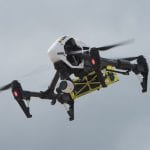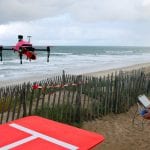
News
German Lifeguards Embrace Water Rescue Drones
The life-saving arm of the German Red Cross, known as the DRK Water Guard, is embracing the potential of drones designed to help save the lives of people who find themselves in distress in the Baltic Sea and surrounding bodies of water.
The DRK Water Guard has equipped itself with 18 drones this summer in the Baltic region that are able to drop a lifebelt to swimmers in the case of emergency.
The drone, which can respond faster than any lifeguard, flies at speeds of was 85 km/h, explained the President of the DRC Mecklenburg-Western Pomerania, Werner Kuhn.
Once a drowning person is spotted, the drone, which is equipped with a camera, flies to the distressed person and deploys the buoyancy aid. In doing so, the the person can survive by holding onto the floating device until a lifeguard arrives.
- At about 65 kilometers per hour, the drone flies over the Baltic Sea to the casualty and flops a buoyancy aid next to the victim into the water | Stefan Sauer
- After a successful trial period, the rescue drones will deployed on the beaches of the Baltic Sea | Bob Edme/AP
The DRK stresses that tourists and swimmers need not be concerned about about privacy or harrassment due to the live streaming of images from the drone’s camera, said Kuhn. The device is only deployed if someone is in trouble, and images streamed by the drone are not saved.
The use of the drones for water rescue by the DRK Water Guard is a first in Germany. Having already been tested on the Baltic coast last year, they will now be used starting next week, across 14 beaches on the Baltic Sea and four major lakes in the country.
“The drones are not meant to replace personnel, but they can quickly be at the scene of an accident and discard plastic hoses that automatically inflate in the water,” said Thomas Powasserat of the German Red Cross Water Authority in Mecklenburg-Vorpommern. “This can help to gain time until the lifeguards are there.”
Drones have similarly been deployed in Australia, for example by the Westpac Little Ripper surf surveillance drone which saved the lives of two teenagers at Lennox Head on Australia’s east coast this January. The drone, which had literally only just been taken out of the box, also deployed a flotation device.




















